【中考考点清单】2014年中考英语(湖南专用 新课标)总复习课件:第二部分 语法专题突破 专题十三 简单句(含13年中考试题)
文档属性
| 名称 | 【中考考点清单】2014年中考英语(湖南专用 新课标)总复习课件:第二部分 语法专题突破 专题十三 简单句(含13年中考试题) |  | |
| 格式 | zip | ||
| 文件大小 | 290.5KB | ||
| 资源类型 | 教案 | ||
| 版本资源 | 通用版 | ||
| 科目 | 英语 | ||
| 更新时间 | 2014-01-22 07:59:09 | ||
图片预览


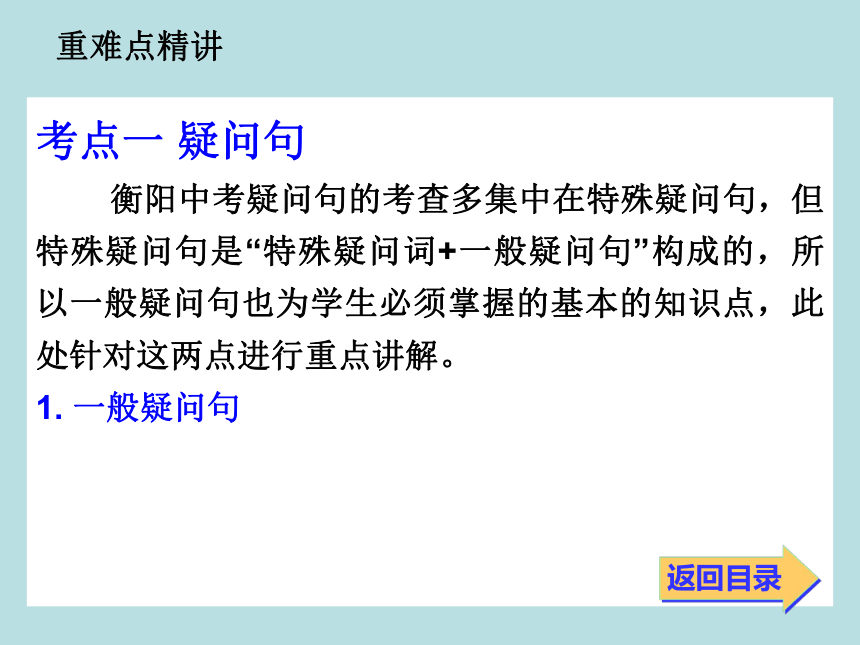



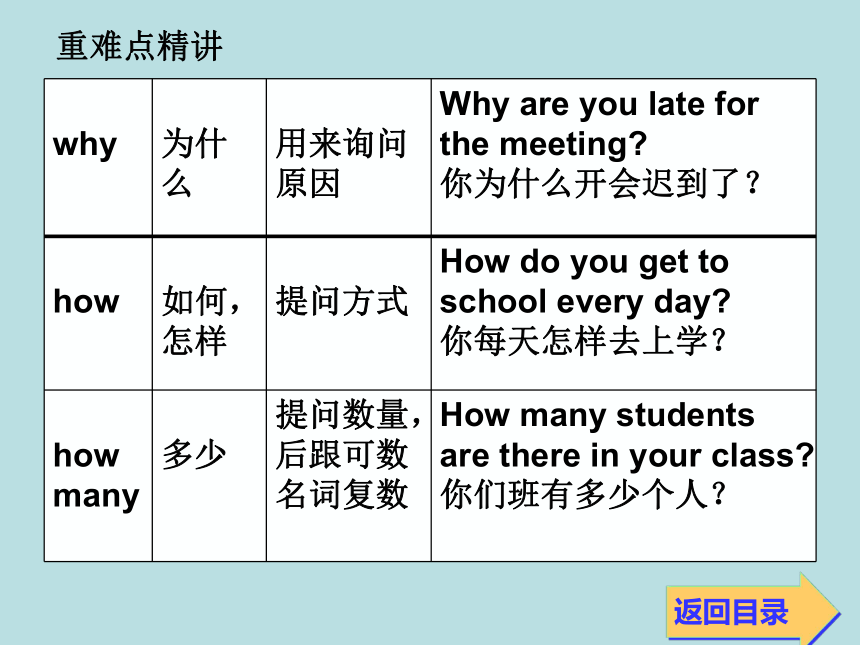

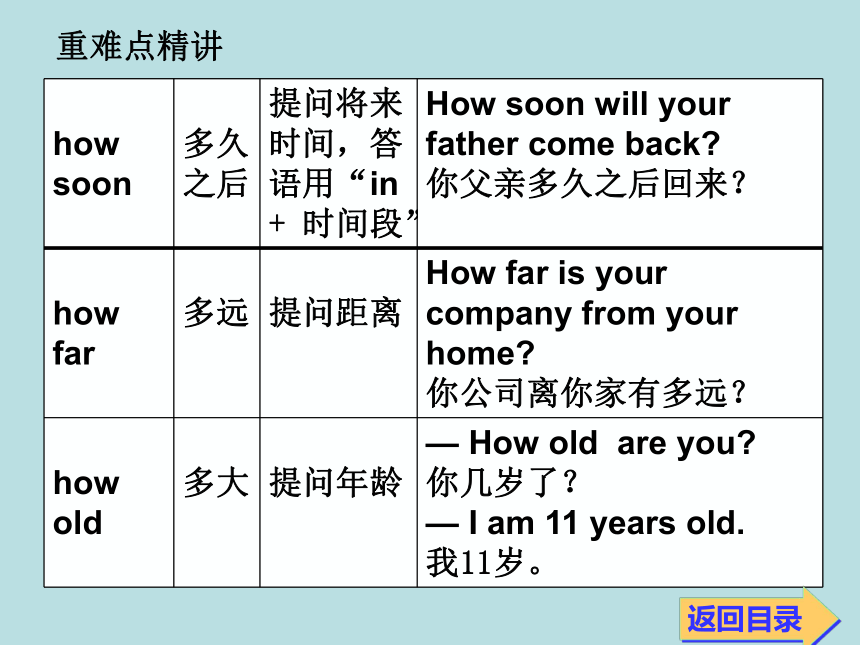
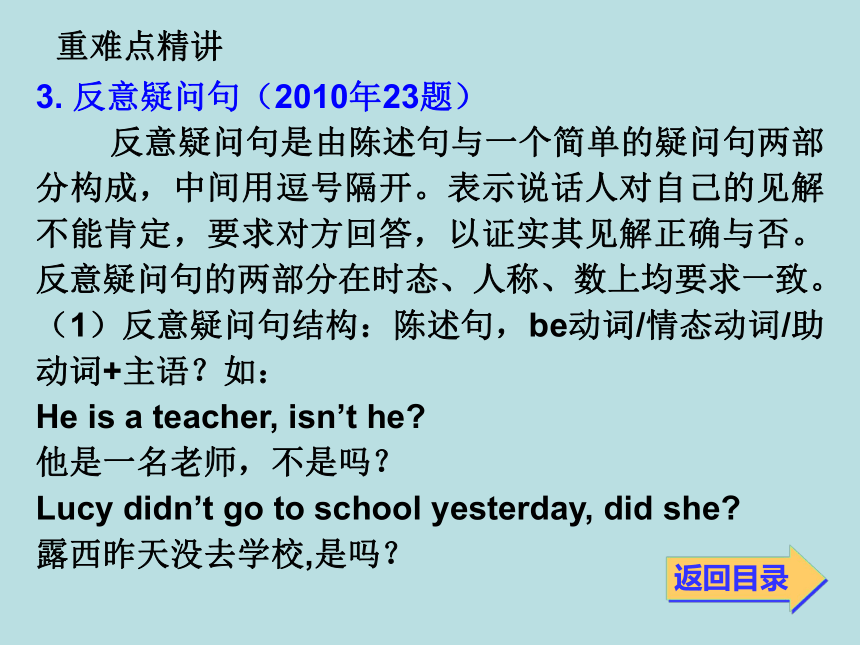
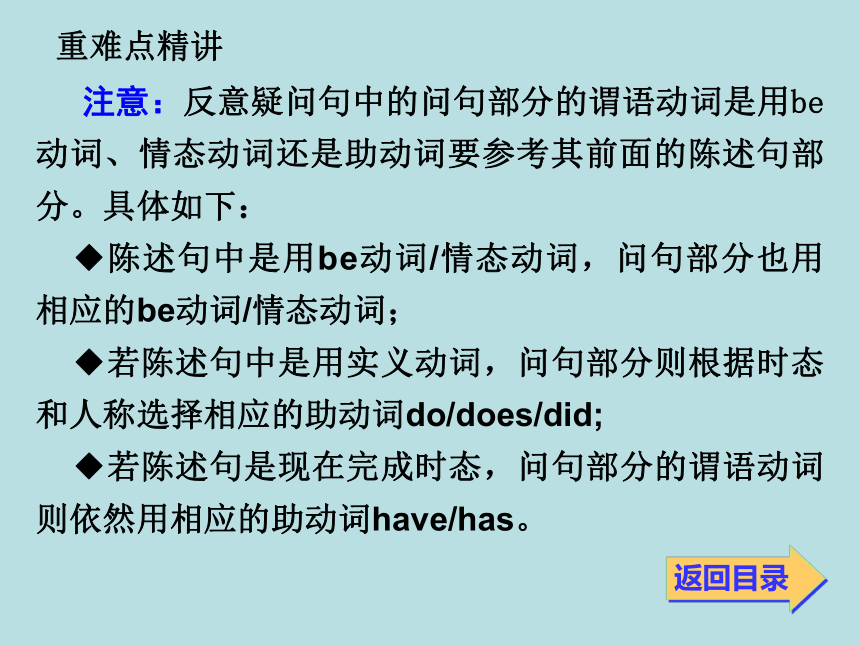
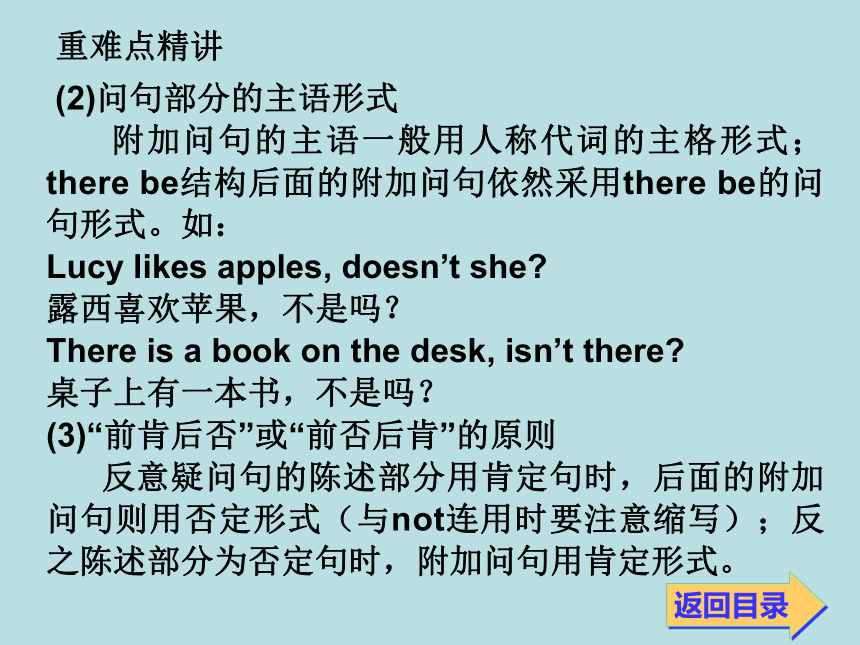
文档简介
课件42张PPT。
重难点精讲 专题十三 简单句考点一 疑问句
考点二 感叹句
考点三 there be句型(2012年24题,
2010年21题)
考点四 主谓一致(2011年31题,2009年
21题)
考点五 倒装句(2011年26题,2009年32
题)
考点六 祈使句考点一 疑问句
衡阳中考疑问句的考查多集中在特殊疑问句,但特殊疑问句是“特殊疑问词+一般疑问句”构成的,所以一般疑问句也为学生必须掌握的基本的知识点,此处针对这两点进行重点讲解。
1. 一般疑问句
重难点精讲返回目录重难点精讲返回目录2. 特殊疑问句(2012年30题,2010年19题)
重难点精讲返回目录重难点精讲返回目录重难点精讲返回目录重难点精讲返回目录重难点精讲返回目录3. 反意疑问句(2010年23题)
反意疑问句是由陈述句与一个简单的疑问句两部分构成,中间用逗号隔开。表示说话人对自己的见解不能肯定,要求对方回答,以证实其见解正确与否。反意疑问句的两部分在时态、人称、数上均要求一致。
(1)反意疑问句结构:陈述句,be动词/情态动词/助动词+主语?如:
He is a teacher, isn’t he?
他是一名老师,不是吗?
Lucy didn’t go to school yesterday, did she?
露西昨天没去学校,是吗?
重难点精讲返回目录 注意:反意疑问句中的问句部分的谓语动词是用be动词、情态动词还是助动词要参考其前面的陈述句部分。具体如下:
◆陈述句中是用be动词/情态动词,问句部分也用相应的be动词/情态动词;
◆若陈述句中是用实义动词,问句部分则根据时态和人称选择相应的助动词do/does/did;
◆若陈述句是现在完成时态,问句部分的谓语动词则依然用相应的助动词have/has。重难点精讲返回目录 (2)问句部分的主语形式
附加问句的主语一般用人称代词的主格形式;there be结构后面的附加问句依然采用there be的问句形式。如:
Lucy likes apples, doesn’t she?
露西喜欢苹果,不是吗?
There is a book on the desk, isn’t there?
桌子上有一本书,不是吗?
(3)“前肯后否”或“前否后肯”的原则
反意疑问句的陈述部分用肯定句时,后面的附加问句则用否定形式(与not连用时要注意缩写);反之陈述部分为否定句时,附加问句用肯定形式。重难点精讲返回目录(陈述部分含有否定词not, never, hardly, seldom, few, little, neither, no, no one, nobody, nothing, none等时应视为否定句)。如:
Lucy often goes to school on foot, doesn’t she? 露西常常步行去上学, 对吧?
You haven’t finished your homework, have you? 你还没有完成工作, 是不是?
Some plants never blossom, do they?
一些植物从不开花,是吗?
(4)陈述部分为祈使句的反意疑问句
祈使句的反意疑问句无论肯定或否定,其附加问句一般都可用will you?
重难点精讲返回目录(6)I (don’t)think/believe/guess/expect等引导的宾语从句,后面的附加问句部分应与宾语从句相对应。如:
I don’t think he is right, is he?
我认为他是不对的,是吗?
【现学现用】
1.(’12衡阳30题)---____the population of China?
--- It’s about 1.3 billion.
A. What’s B. How many is C. How much is
2. (’10 衡阳19题)--- ____does Wang Han do?
---He is a host. He works in Hunan TV station.
A. What B. Where C. Which
A A重难点精讲返回目录3.(’10衡阳23题)--- Amy put her books away just now, ____ she?
--- Yes, I saw her do it.
A. doesn’t B. wasn’t C. didn’t
4. --- ____do you have an Art Festival in your school?
--- Once a year.
A. How long B. How often C. How far
5. --- What a lovely teddy bear! ____is it?
--- One hundred yuan.
A. How much B. How long C. How many
C B A重难点精讲返回目录6. --- How long have you lived in Datong?
---____.
A. For about ten years B. Ten years ago
C. In ten years
7. --- ____students are there in your class?
--- 35.
A. How many B. How long C. How much
8. --- ____will the supper be ready? I’m very hungry.
--- In a minute.
A. How soon B. How long C. How much
A A A重难点精讲返回目录 但以 Let’s(注意不是let us)开头的祈使句的反意疑问句其附加问句用shall we?
Be sure to come on time, will you?
保证按时来,好吗?
Let’s have a rest, shall we?
咱们休息一下,好吗?
(5)反意疑问句的回答
反意疑问句的回答形式类似于一般疑问句,即yes后面无not, 用no后面带not。当反意疑问句为“前肯后否”时,yes仍译作“是”,no译作“不”; 当反意疑问句为“前否后肯”时,yes译为“不”, 而no译成“是”。
重难点精讲返回目录9. ---Sue, you usually go to work by subway. is it from your home to the office?
--- It’s about 50 kilometers.
A. How soon B. How long C. How far
10. --- I’m planning to visit the Yellow River Delta National Nature Reserve(黄河三角洲国家级自然保护区). ____is it?
--- It’s natural and beautiful. I think tourists can enjoy wonderful views there.
A. How B. What C. Where
C A重难点精讲返回目录
11. --- ____is your father?
--- A bank clerk. He works in a bank near my home.
A. How B. What C. Which B重难点精讲返回目录考点二 感叹句
衡阳中考在单项选择中没有直接考查,但是在情景对话中有出现感叹句。
在句型转换、补充对话以及书面表达中都会用到感叹句, 要求学生牢固掌握感叹句的构成及引导词的判断。
感叹句的构成重难点精讲返回目录返回目录重难点精讲返回目录
【方法突破】
感叹句引导词的判断
方法一:凡是有a, an开头的,多用what;
方法二:凡是形容词直接加名词的,多用what;
方法三:其他一般用how。
重难点精讲返回目录
【现学现用】
12. ____wonderful concert they are putting on in the city square!
A. How B. What a C. What an
13. ____bright sunshine! Let’s have a picnic.
A. What B. How C. What a B A重难点精讲返回目录14. ____interesting it is to go sailing in
Qingdao in summer!
A. What B. What an C. How
15. ____information he offered us! We all thank
him.
A. What useful B. What useless
C. How useful
重难点精讲返回目录 C A考点三 there be句型(2012年24题,2010年21题)
◆“there + be + sb. /sth.+地点”表示“某处有某人或某物”。动词be必须和主语保持人称和数的一致。如果主语部分是两个以上的并列主语时,be一般和就近主语的数和人称保持一致。
◆ “there + be + sb. /sth.+地点”的否定形式是在动词be后面加not, not any, no。
◆ 若变为一般疑问句则需要把be提前到句首。
注意:there be 结构有不同的时态,而且可以和各种助动词或情态动词连用。如:
重难点精讲返回目录There used to be several houses behind the two buildings.
过去这两幢楼后面有几所房子。
There was a sports meeting yesterday.
昨天举行了一场运动会。
There will be(=There is going to be)a new film on Monday.
星期一将有一部新电影上映。
There have been a lot of accidents around here. 这里已经发生了多起事故。
There must be a mistake somewhere.
肯定有某个地方出错了。
重难点精讲返回目录【现学现用】
16. (’12衡阳24题)David, there a dictionary and some books on your desk. Please put them away.
A. is B. are C. have
17.(’10衡阳21题)---Shigu park is beautiful!
--- Yeah, there ____many visitors every year.
A. is B. are C. has
18. --- ____there any food for the drivers and passengers?
--- Yes, ____.
A. Are; there are B. Is; it is C. Is; there is
A B C重难点精讲返回目录
19. ____something wrong with my bike. Can I use yours?
A. It is B. It was C. There is
20. ____a big party in our school in two weeks.
A. There has B. There is going to be
C. There is going to have
C B返回目录考点四 主谓一致(2011年31题,2009年21题)
主谓一致指谓语动词在人称和数上必须和主语保持一致。其中就近原则和集体名词是中考常考点,考生必须牢固掌握。
就近原则:谓语动词的单复数由离它最近的词决定。常用句型有:there be, not only...but also, neither...nor, either...or...等。如:
Neither you nor he has been to the city.
你和他都没去过那个城市。
There is some money and two keys in the pocket.在那个口袋里有一些钱和两把钥匙。
重难点精讲返回目录 某些集体名词,如family, class, government, group等作主语时,如果作为一个整体看待,谓语动词用单数形式;如果侧重其中一个成员,谓语动词用复数。如:
His family is going to move to Beijing.
他家将搬到北京去。
The whole family are watching TV.
全家人正在看电视。
【现学现用】
21.(’11衡阳31题)---Do you like your new T-shirt?
---Yes. Not only I but also my mother ____it.
A. likes B. like C. doesn’t like
A重难点精讲返回目录
22.(’09衡阳21题)Either Tom or she____going
to the party next week. One of them must stay at
home.
A. are B. was C. is
23. —Both Li Lei and Han Meimei ____fond of the
TV program A Bite of China.
—I am also deeply moved by its stories!
A. is B. am C. are
C C重难点精讲返回目录考点五 倒装句(2011年26题,2009年32题)
1. 倒装句的结构
so+助动词/系动词/情态动词+主语(表肯定)
neither/nor+助动词/系动词/情态动词+主语(表否定)
这两种结构用来说明前面所说的情况也同样适用于后面的主语,意思是“某人/物也(不)这样”。结构中的助动词(或系动词或情态动词)在形式上与前面的谓语动词保持一致,而其数则由其主语决定。如:
重难点精讲返回目录Lucy is a good student, so is Lily.
露西是个好学生,莉莉也是个好学生。
注意:若对前面所说的事实加以肯定时,应用so+主语+助动词/系动词/情态动词。前后两个句子的主语为同一个人或物。如:
—He likes English. 他喜欢英语。
—So he does. 的确如此。
2. 副词引导的倒装句
在以here, there, out, in, down, away等表示方位的副词开头的句子中,如果主语是名词时,要用倒装语序。因此谓语动词的形式由位于倒装句句尾的主语决定。如:
There goes the bell. 铃响了。
重难点精讲返回目录Here is a flower. 这儿有一朵花。
注意:如果主语是人称代词,则不用倒装。如:
Here you are. 给你。
【现学现用】
24. (’11衡阳26题)---Peter, I will visit our teacher this Sunday.
--- . Let’s go together.
A. Nor do I B. I will so C. So will I
25.(’09衡阳32题)―Julia loves hip-hop music very much.
― . She practices it every day.
A. So does she B. So do I C. So she does
C C重难点精讲返回目录考点六 祈使句
1. 句式结构
重难点精讲返回目录重难点精讲返回目录2. 应答祈使句时要用将来时
①—Please remember to take the dog out for a walk every day. 请记住每天带着狗散步。
—Yes, I will. 好的,我会的。
②—Don’t take your mobile phone to school.
不要把手机带到学校来!
—Sorry, I won’t. 对不起,我不会了。
3. 掌握“祈使句+and/or+结果状语”结构。如:
Work harder, and you’ll get good grades.
再努力一把,你就会取得好成绩。
Hurry up, or you’ll be late for class.
快点,不然上课就要迟到了。
重难点精讲返回目录
句子种类口诀
句子按用途分四大体,陈述疑问感叹和祈使。
陈述用来叙述一件事。疑问主要用来提问题。
祈使表达命令和请求。表达强烈感情感叹句。
上述九是句种之定义。祈使主语you被抛弃。
若将其变成否定形式,动词之前加don’t是正理。
重难点精讲返回目录【现学现用】
26. Please ____open the door. It is very cold outside.
A. do B. don’t C. doesn’t
27. —I’m leaving now.
— ____you turn off the lights and the computer.
A. To make sure B. Make sure C. Making sure
28. ____this rock music, please. I’m afraid some people can’t stand the noise!
A. Stopping B. Stop C. Stops
B B B重难点精讲返回目录29. —Peter has made great progress in math recently.
— , and so have you.
A. So he does B. So he has C. So has he
【易错点】反意疑问句用法
John had a short walk after lunch, ?
A. did he B. didn’t he C. had he
【点拨】B 考查反意疑问句用法。反意疑问句遵循“前肯(否)后否(肯)”原则。本题陈述句部分为肯定句,则反意疑问部分用否定形式,据此排除A、C项。故选B。
B重难点精讲返回目录【易混点】感叹句用法
____nice weather it is! Let’s play football.
A. What B. How C. What a
【点拨】A考查感叹句用法辨析。以what引导的感叹句结构为:“What + a/ an + adj. + 可数名词单数(+主语+谓语)!”或“What + adj. + 不可数名词/ 可数名词复数(+ 主语 + 谓语)!”以how引导的感叹句的结构为:“How + adj. + a/ an + 可数名词单数(+ 主语+ 谓语)!”或“How + adj. + 主语 + 谓语!”。本题中的weather为不可数名词。故选A。
重难点精讲返回目录
重难点精讲 专题十三 简单句考点一 疑问句
考点二 感叹句
考点三 there be句型(2012年24题,
2010年21题)
考点四 主谓一致(2011年31题,2009年
21题)
考点五 倒装句(2011年26题,2009年32
题)
考点六 祈使句考点一 疑问句
衡阳中考疑问句的考查多集中在特殊疑问句,但特殊疑问句是“特殊疑问词+一般疑问句”构成的,所以一般疑问句也为学生必须掌握的基本的知识点,此处针对这两点进行重点讲解。
1. 一般疑问句
重难点精讲返回目录重难点精讲返回目录2. 特殊疑问句(2012年30题,2010年19题)
重难点精讲返回目录重难点精讲返回目录重难点精讲返回目录重难点精讲返回目录重难点精讲返回目录3. 反意疑问句(2010年23题)
反意疑问句是由陈述句与一个简单的疑问句两部分构成,中间用逗号隔开。表示说话人对自己的见解不能肯定,要求对方回答,以证实其见解正确与否。反意疑问句的两部分在时态、人称、数上均要求一致。
(1)反意疑问句结构:陈述句,be动词/情态动词/助动词+主语?如:
He is a teacher, isn’t he?
他是一名老师,不是吗?
Lucy didn’t go to school yesterday, did she?
露西昨天没去学校,是吗?
重难点精讲返回目录 注意:反意疑问句中的问句部分的谓语动词是用be动词、情态动词还是助动词要参考其前面的陈述句部分。具体如下:
◆陈述句中是用be动词/情态动词,问句部分也用相应的be动词/情态动词;
◆若陈述句中是用实义动词,问句部分则根据时态和人称选择相应的助动词do/does/did;
◆若陈述句是现在完成时态,问句部分的谓语动词则依然用相应的助动词have/has。重难点精讲返回目录 (2)问句部分的主语形式
附加问句的主语一般用人称代词的主格形式;there be结构后面的附加问句依然采用there be的问句形式。如:
Lucy likes apples, doesn’t she?
露西喜欢苹果,不是吗?
There is a book on the desk, isn’t there?
桌子上有一本书,不是吗?
(3)“前肯后否”或“前否后肯”的原则
反意疑问句的陈述部分用肯定句时,后面的附加问句则用否定形式(与not连用时要注意缩写);反之陈述部分为否定句时,附加问句用肯定形式。重难点精讲返回目录(陈述部分含有否定词not, never, hardly, seldom, few, little, neither, no, no one, nobody, nothing, none等时应视为否定句)。如:
Lucy often goes to school on foot, doesn’t she? 露西常常步行去上学, 对吧?
You haven’t finished your homework, have you? 你还没有完成工作, 是不是?
Some plants never blossom, do they?
一些植物从不开花,是吗?
(4)陈述部分为祈使句的反意疑问句
祈使句的反意疑问句无论肯定或否定,其附加问句一般都可用will you?
重难点精讲返回目录(6)I (don’t)think/believe/guess/expect等引导的宾语从句,后面的附加问句部分应与宾语从句相对应。如:
I don’t think he is right, is he?
我认为他是不对的,是吗?
【现学现用】
1.(’12衡阳30题)---____the population of China?
--- It’s about 1.3 billion.
A. What’s B. How many is C. How much is
2. (’10 衡阳19题)--- ____does Wang Han do?
---He is a host. He works in Hunan TV station.
A. What B. Where C. Which
A A重难点精讲返回目录3.(’10衡阳23题)--- Amy put her books away just now, ____ she?
--- Yes, I saw her do it.
A. doesn’t B. wasn’t C. didn’t
4. --- ____do you have an Art Festival in your school?
--- Once a year.
A. How long B. How often C. How far
5. --- What a lovely teddy bear! ____is it?
--- One hundred yuan.
A. How much B. How long C. How many
C B A重难点精讲返回目录6. --- How long have you lived in Datong?
---____.
A. For about ten years B. Ten years ago
C. In ten years
7. --- ____students are there in your class?
--- 35.
A. How many B. How long C. How much
8. --- ____will the supper be ready? I’m very hungry.
--- In a minute.
A. How soon B. How long C. How much
A A A重难点精讲返回目录 但以 Let’s(注意不是let us)开头的祈使句的反意疑问句其附加问句用shall we?
Be sure to come on time, will you?
保证按时来,好吗?
Let’s have a rest, shall we?
咱们休息一下,好吗?
(5)反意疑问句的回答
反意疑问句的回答形式类似于一般疑问句,即yes后面无not, 用no后面带not。当反意疑问句为“前肯后否”时,yes仍译作“是”,no译作“不”; 当反意疑问句为“前否后肯”时,yes译为“不”, 而no译成“是”。
重难点精讲返回目录9. ---Sue, you usually go to work by subway. is it from your home to the office?
--- It’s about 50 kilometers.
A. How soon B. How long C. How far
10. --- I’m planning to visit the Yellow River Delta National Nature Reserve(黄河三角洲国家级自然保护区). ____is it?
--- It’s natural and beautiful. I think tourists can enjoy wonderful views there.
A. How B. What C. Where
C A重难点精讲返回目录
11. --- ____is your father?
--- A bank clerk. He works in a bank near my home.
A. How B. What C. Which B重难点精讲返回目录考点二 感叹句
衡阳中考在单项选择中没有直接考查,但是在情景对话中有出现感叹句。
在句型转换、补充对话以及书面表达中都会用到感叹句, 要求学生牢固掌握感叹句的构成及引导词的判断。
感叹句的构成重难点精讲返回目录返回目录重难点精讲返回目录
【方法突破】
感叹句引导词的判断
方法一:凡是有a, an开头的,多用what;
方法二:凡是形容词直接加名词的,多用what;
方法三:其他一般用how。
重难点精讲返回目录
【现学现用】
12. ____wonderful concert they are putting on in the city square!
A. How B. What a C. What an
13. ____bright sunshine! Let’s have a picnic.
A. What B. How C. What a B A重难点精讲返回目录14. ____interesting it is to go sailing in
Qingdao in summer!
A. What B. What an C. How
15. ____information he offered us! We all thank
him.
A. What useful B. What useless
C. How useful
重难点精讲返回目录 C A考点三 there be句型(2012年24题,2010年21题)
◆“there + be + sb. /sth.+地点”表示“某处有某人或某物”。动词be必须和主语保持人称和数的一致。如果主语部分是两个以上的并列主语时,be一般和就近主语的数和人称保持一致。
◆ “there + be + sb. /sth.+地点”的否定形式是在动词be后面加not, not any, no。
◆ 若变为一般疑问句则需要把be提前到句首。
注意:there be 结构有不同的时态,而且可以和各种助动词或情态动词连用。如:
重难点精讲返回目录There used to be several houses behind the two buildings.
过去这两幢楼后面有几所房子。
There was a sports meeting yesterday.
昨天举行了一场运动会。
There will be(=There is going to be)a new film on Monday.
星期一将有一部新电影上映。
There have been a lot of accidents around here. 这里已经发生了多起事故。
There must be a mistake somewhere.
肯定有某个地方出错了。
重难点精讲返回目录【现学现用】
16. (’12衡阳24题)David, there a dictionary and some books on your desk. Please put them away.
A. is B. are C. have
17.(’10衡阳21题)---Shigu park is beautiful!
--- Yeah, there ____many visitors every year.
A. is B. are C. has
18. --- ____there any food for the drivers and passengers?
--- Yes, ____.
A. Are; there are B. Is; it is C. Is; there is
A B C重难点精讲返回目录
19. ____something wrong with my bike. Can I use yours?
A. It is B. It was C. There is
20. ____a big party in our school in two weeks.
A. There has B. There is going to be
C. There is going to have
C B返回目录考点四 主谓一致(2011年31题,2009年21题)
主谓一致指谓语动词在人称和数上必须和主语保持一致。其中就近原则和集体名词是中考常考点,考生必须牢固掌握。
就近原则:谓语动词的单复数由离它最近的词决定。常用句型有:there be, not only...but also, neither...nor, either...or...等。如:
Neither you nor he has been to the city.
你和他都没去过那个城市。
There is some money and two keys in the pocket.在那个口袋里有一些钱和两把钥匙。
重难点精讲返回目录 某些集体名词,如family, class, government, group等作主语时,如果作为一个整体看待,谓语动词用单数形式;如果侧重其中一个成员,谓语动词用复数。如:
His family is going to move to Beijing.
他家将搬到北京去。
The whole family are watching TV.
全家人正在看电视。
【现学现用】
21.(’11衡阳31题)---Do you like your new T-shirt?
---Yes. Not only I but also my mother ____it.
A. likes B. like C. doesn’t like
A重难点精讲返回目录
22.(’09衡阳21题)Either Tom or she____going
to the party next week. One of them must stay at
home.
A. are B. was C. is
23. —Both Li Lei and Han Meimei ____fond of the
TV program A Bite of China.
—I am also deeply moved by its stories!
A. is B. am C. are
C C重难点精讲返回目录考点五 倒装句(2011年26题,2009年32题)
1. 倒装句的结构
so+助动词/系动词/情态动词+主语(表肯定)
neither/nor+助动词/系动词/情态动词+主语(表否定)
这两种结构用来说明前面所说的情况也同样适用于后面的主语,意思是“某人/物也(不)这样”。结构中的助动词(或系动词或情态动词)在形式上与前面的谓语动词保持一致,而其数则由其主语决定。如:
重难点精讲返回目录Lucy is a good student, so is Lily.
露西是个好学生,莉莉也是个好学生。
注意:若对前面所说的事实加以肯定时,应用so+主语+助动词/系动词/情态动词。前后两个句子的主语为同一个人或物。如:
—He likes English. 他喜欢英语。
—So he does. 的确如此。
2. 副词引导的倒装句
在以here, there, out, in, down, away等表示方位的副词开头的句子中,如果主语是名词时,要用倒装语序。因此谓语动词的形式由位于倒装句句尾的主语决定。如:
There goes the bell. 铃响了。
重难点精讲返回目录Here is a flower. 这儿有一朵花。
注意:如果主语是人称代词,则不用倒装。如:
Here you are. 给你。
【现学现用】
24. (’11衡阳26题)---Peter, I will visit our teacher this Sunday.
--- . Let’s go together.
A. Nor do I B. I will so C. So will I
25.(’09衡阳32题)―Julia loves hip-hop music very much.
― . She practices it every day.
A. So does she B. So do I C. So she does
C C重难点精讲返回目录考点六 祈使句
1. 句式结构
重难点精讲返回目录重难点精讲返回目录2. 应答祈使句时要用将来时
①—Please remember to take the dog out for a walk every day. 请记住每天带着狗散步。
—Yes, I will. 好的,我会的。
②—Don’t take your mobile phone to school.
不要把手机带到学校来!
—Sorry, I won’t. 对不起,我不会了。
3. 掌握“祈使句+and/or+结果状语”结构。如:
Work harder, and you’ll get good grades.
再努力一把,你就会取得好成绩。
Hurry up, or you’ll be late for class.
快点,不然上课就要迟到了。
重难点精讲返回目录
句子种类口诀
句子按用途分四大体,陈述疑问感叹和祈使。
陈述用来叙述一件事。疑问主要用来提问题。
祈使表达命令和请求。表达强烈感情感叹句。
上述九是句种之定义。祈使主语you被抛弃。
若将其变成否定形式,动词之前加don’t是正理。
重难点精讲返回目录【现学现用】
26. Please ____open the door. It is very cold outside.
A. do B. don’t C. doesn’t
27. —I’m leaving now.
— ____you turn off the lights and the computer.
A. To make sure B. Make sure C. Making sure
28. ____this rock music, please. I’m afraid some people can’t stand the noise!
A. Stopping B. Stop C. Stops
B B B重难点精讲返回目录29. —Peter has made great progress in math recently.
— , and so have you.
A. So he does B. So he has C. So has he
【易错点】反意疑问句用法
John had a short walk after lunch, ?
A. did he B. didn’t he C. had he
【点拨】B 考查反意疑问句用法。反意疑问句遵循“前肯(否)后否(肯)”原则。本题陈述句部分为肯定句,则反意疑问部分用否定形式,据此排除A、C项。故选B。
B重难点精讲返回目录【易混点】感叹句用法
____nice weather it is! Let’s play football.
A. What B. How C. What a
【点拨】A考查感叹句用法辨析。以what引导的感叹句结构为:“What + a/ an + adj. + 可数名词单数(+主语+谓语)!”或“What + adj. + 不可数名词/ 可数名词复数(+ 主语 + 谓语)!”以how引导的感叹句的结构为:“How + adj. + a/ an + 可数名词单数(+ 主语+ 谓语)!”或“How + adj. + 主语 + 谓语!”。本题中的weather为不可数名词。故选A。
重难点精讲返回目录
同课章节目录
- 词法
- 名词
- 动词和动词短语
- 动词语态
- 动词时态
- 助动词和情态动词
- 非谓语动词
- 冠词
- 代词
- 数词和量词
- 形容词副词及其比较等级
- 介词和介词短语
- 连词和感叹词
- 构词法
- 相似、相近词比较
- 句法
- 陈述句
- 一般疑问句和否定疑问句
- 特殊疑问句及选择疑问句
- 反意疑问句
- 存在句(There be句型)
- 宾语从句
- 定语从句
- 状语从句
- 主谓一致问题
- 简单句
- 并列句
- 复合句
- 主谓一致
- 主、表语从句
- 名词性从句
- 直接引语和间接引语
- 虚拟语气
- 感叹句
- 强调句
- 倒装句
- 祈使句
- 句子的成分
- 句子的分类
- 题型专区
- 单项选择部分
- 易错题
- 完形填空
- 阅读理解
- 词汇练习
- 听说训练
- 句型转换
- 补全对话
- 短文改错
- 翻译
- 书面表达
- 任务型阅读
- 语法填空
- 其他资料
